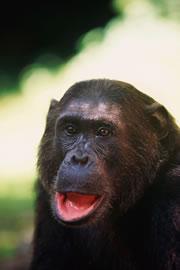 We split from chimps millions of years ago - but might have taken our time over it.© Getty
We split from chimps millions of years ago - but might have taken our time over it.© GettyThe evolutionary split between humans and our nearest evolutionary cousins, chimpanzees, may have occurred more recently than we thought, according to a new comparison of the respective genetic sequences. What's more, it might have been a messy divorce rather than a clean break — leading to the controversial theory that our two sets of ancestors may have interbred many thousands of years after first parting company.
The discovery also casts doubt on the status of fossils that were thought to represent the first flowering of the human branch of the evolutionary tree — but which now may have to be reclassified as coming from a time before our split with the rest of the apes.
Previous estimates put the split at as much as 7 million years ago — meaning that Toumaï, a fossil dating from at least 6.5 million years ago in Chad and assigned to the species Sahelanthropus tchadensis, was hailed as the earliest-known member of the line that gave rise to modern humans.
But researchers led by David Reich of Harvard Medical School in Boston, Massachusetts, now calculate that the split may have occurred no more than 6.3 million years ago, and possibly as recently as 5.4 million. That would make Toumaï older than the time of the split.
Early days
The researchers make their claim after comparing the genetic codes of humans, chimpanzees, gorillas and other primates in unprecedented detail — more than 20 million DNA 'letters' in all. By checking the differences between different species' DNA sequences, they were able to estimate the time since they first diverged.
But the story is not simple, Reich and his team explain in their study, published online in Nature1. Different sections of the genome differ by different amounts, suggesting that they parted ways at different times. The divorce period between the two species, the data suggest, could have lasted a million years.
The region bearing the most similarity is the X chromosome. This is exactly what one might expect if the two lineages had continued to interbreed after first starting to separate.
The X chromosome, one of the pair of sex-determining chromosomes, is the home of many genes that govern fertility, Reich explains. So any two species that could mate with one another would be expected to have similar X chromosomes. And natural selection would prevent these chromosomes from diverging for as long as the hybridization was going on.
In the family
ADVERTISEMENT
If such a hybrid population really did exist, the question remains as to whether it died out, or whether modern humans or chimpanzees (or both) are its descendants. It's very difficult to say, admits Reich. "The fossil data suggest — very tenuously — that it may have been humans who are descended from the hybrid population."
For some reason, human-like fossils far outnumber chimpanzee-like ones in the fossil record, making it difficult to see exactly who was sleeping with whom at the time.
So where does this leave Toumaï and his ilk? They may have sat in an evolutionary pocket between the initial split and the subsequent hybridization, Reich suggests, or have been around at the time but not involved in the inter-species carnality. Reich says that more fossils and developmental studies will be needed to resolve this tricky question.
Visit our andhuman_ancestors.html">newsblog to read and post comments about this story.
